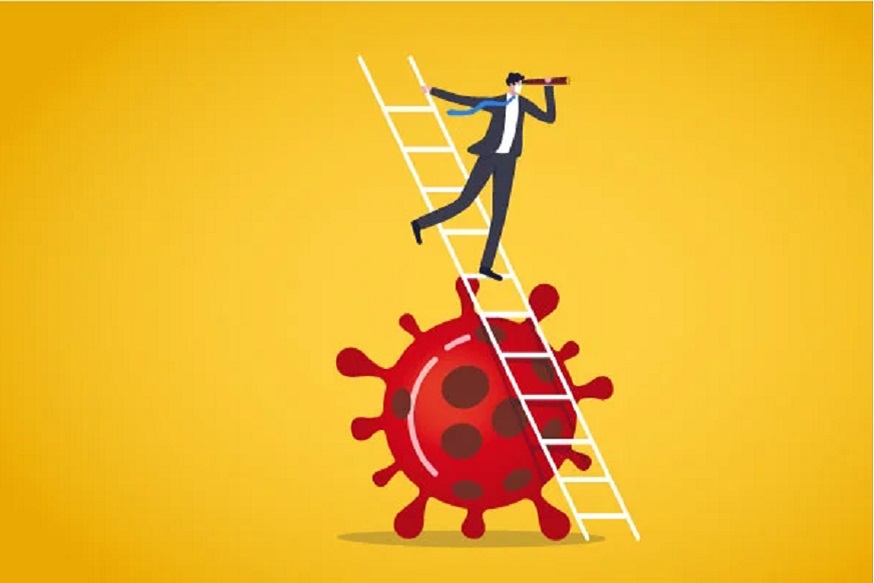WHAT’S NOW?
The IR 4.0 development has become a new direction for many organizations and ecosystems to lead the more rapid development towards a business world that is expected to bring a variety of innovations. Hence, many businesses are undertaking large-scale transition strategies to reap the advantages of these changes or merely to keep up with competitors as emerging innovations radically reshape the industry. However, it is undeniable that IR 4.0 will take quite a long time to realize the aspirations dreamed of by not only the organization but the entire ecosystem who can’t wait to see the glory of innovation to come.
However, the sudden advent of unexpected disruptions, far from the human abilities to predict has led to an acceleration of the need to identify, create and implement digital transformations that will be able to fast-track these innovations. In the serenity of doing business, nobody expected a surprise that will shake this world without any sign. It was March 11, 2020, when World Health Organization declared COVID-19 a pandemic. Far from the eye and far beyond the distance, and that’s what people thought when the coronavirus started its activities in Wuhan city of mainland China. It does not reach the human mind that the advent of the corona will not only be a threat to health but will also change the way of life and ruin the business empire that has been built for so long.
The arrival of COVID-19 has indeed brought about a tremendous challenge that is difficult to explain in ordinary words. The impact on individuals, organizations whether micro, small, large, or multinational, companies, and ecosystems as a whole is extraordinary. The paralysis of the strength of the household economy, the disruption of the organization’s supply chain, the interruption to the country’s economic activities, and the strain on the country’s healthcare system are a few notable areas. Human ignorance of the power of the corona not only shocked the whole world but also proved to all organizations the weakness of the business model that has existed for so long. Hence, “business as usual” has become a thing of the past, thanks to the coronavirus. This proves that in this unpredictable age, there is no such thing as “normal”. Many companies have begun their recovery process as the effects of COVID-19 continue to be felt. However, a pandemic that is continuing to peak with adverse effects on organizational efforts made the business landscape to be much different than it was in the past. To emerge stronger is the only way for organizations to reinvent themselves as they step into post-pandemic business environment.
About the author

Dr. Shathees Baskaran, an Associate Professor at Azman Hashim International Business School, University Technology Malaysia. He is an experienced strategic management professional whose major areas of interest are strategic management where his intellectual contributions can be found. Find out more from https://business.utm.my/shathees_intro/
In light of the continuing pandemic and uncertainty surrounding the organizations, assumptions historically used to formulate strategic options in setting their strategic path are now being called into question. Altering those presumptions, re-evaluating all circumstances, and progressing their capacity to predict and respond in an opportune way are all part of this process now. Organizations that are capable of navigating uncertainty will be better prepared with the ability to survive through high resilience regardless of any upcoming changes. There is still no sign when the pandemic that has plagued this world will end. However, the shock that arose over the past years has now become a new norm, and organizations and customers have begun to adjust to this new routine.




WHAT’S NEXT?
The emergence of IR 4.0 and its acceleration through the coronavirus’s appearance allows everyone to reconsider the changes we’ve to embrace in our lives and businesses. The modern world requires a stronger, but more robust architecture that addresses both global challenges and opportunities. The overall challenges in the industry thrown by IR4.0 is still not fully addressed, and covid-19 arrives with another very strong impact, making the present state more uncontrollable. COVID-19 was a visible contributor to the market collapses of 2020 without any sign of a near future rebound, and the economies were still vulnerable and precarious. The pain and uncertainty of market crashes are continuing and it is unclear if this is normal in a “new normal” business environment. If so, uncertainties whether the industries are ready for (further) market consolidations as a result of financial collapses; will micro, small, and medium enterprises make a comeback or at worse will be forced to exit and re-enter the market with a fresh yet different business model are still surrounded by countless assumptions.
It is essential to acknowledge that COVID-19’s effect would be strongly influenced by how long the pandemic lasts. By the time the global pandemic comes to an end which remained uncertain, most of the economic chains will be disrupted, collapsing small boys and forcing them to exit the economic system, weakening the big boys and forcing them to either undergo rescaling or to a worse extent, to exit the market, and stronger boys take control through consolidation. Moreover, if the situation is expected to get worse, are they prepared for the next crash? What will this lead to, especially in the context of market consolidation and restructuring? Where is the fate of small traders who are no longer able to survive due to further market crashes which are still ambiguous? This leads to viewing the future from three different focus areas, namely the new (consolidated) markets, the customers defined by these new markets, and also the organizational strategies driven by re-segmented consumer characteristics.
Consumer characteristics are an all-time significant component in a business architecture since a greater understanding of consumer preferences and experiences will greatly assist an organization to perform and more importantly, be competitive and stay relevant in the marketplace. The rapid development in technology in IR 4.0 and internet technology has had a significant effect on how people collaborate, interact, and perform business practices. To add to this severity, the emergence of coronavirus has not accelerated the pace but also reshaped the customers’ and consumers’ characteristics. Changes in the world have inevitably resulted in the introduction of new customer and marketplace perspectives. Unimaginable changes brought about by coronavirus coupled with pacing IR 4.0 has shown that consumers are transforming into active users of online lifestyle that has significantly accelerated their shopping journey by allowing complete flexibility to their choices and decisions. The drastic turnaround in customers’ and consumers’ lifestyles has questioned traditional practices of understanding them, instead of calling for the identification and classification of technology-defined consumer characteristics. This is set as the second most focus in resigning the business strategy. The successful adoption of a digital lifestyle eliminates the geographical radius of their options and possibly removes the stickiness of dedicated merchants. Owing to multiple borderless options, customers will start moving virtually beyond their geographical location, keeping aside the spatial distance to optimize their seamless customer experience, prompting the further proliferation of limitless niche market segments and consequently splintering share of wallet across many providers.
Given the time taken to gain global public immunity is limited, the first focus portrays a scenario in which organizations resume routine operations after a reasonable recovery from the period of downturn. This recovery may no longer follow traditional business models. A shift in business models is an unavoidable imperative for organizations. As market consolidation is underway, emerging market structures will redefine the newer characteristics of value-conscious consumers. The traditional approaches such as loyalty programs may require new ways of creating their raving fans and certainly will disrupt current practices in place requiring remodelling of their value prepositions. In a consolidated market structure, commonly accepted value prepositions (operational excellence, product leadership, or customer intimacy) may remain valid but what alterations are needed will be dictated by the re-segmentation of the organizations’ relevant market. Given changes in the marketplace and its governing structures, a redefinition of customer trustworthiness, customer satisfaction, and customer referrals may pose newer challenges to organizations’ sustainability. What is more important for the organization will be to embrace a drastic change in its strategy, processes, and mindset from a business strategy supported by technology to a technology-led business strategy.
Key Characteristics of Future Strategy – Long Known, Less Embraced
COVID-19 has put an enormous pressure on businesses today. Its emergence has shown indications that the decisions made today will influence how businesses will be carried out tomorrow. This is not all, there are many more disruptions to come, and organizations today are required to plan their future with carefully designed business strategies given current organizational circumstances to endure the forthcoming challenges. There are varying views on predicting future strategies by experts across the world. Nevertheless, there are two important determinants in predicting future strategies for an organization. The first is organizational resilience and the second will be organizational agility.

While resilience is a dynamic concept, in general terms organizational resilience refers to the organization’s ability to adapt, survive, and return to a “normality” state after the occurrence of unexpected turbulences although there is a general thinking that to be resilient is to bend but not to break. Usually, an organization that has low resilience to exogenous changes and shocks will start to recover from perturbations with its adaptive capacity while starting to innovate to recuperate from the disruptions caused by the environment. However, an organization with rigid structures is less resilient to exogenous changes and shocks since there are no slack resources to adapt to changing business dynamics. A change of rigid structures to a more resilient adaptive capacity requires far-reaching changes, whether innate or deliberate in the business strategy that will be different than the pre-crisis period. This may lead the organizations to fundamentally a different state by creating new ways of doing business. In this sense, strategic resilience which reinvents business models is needed for the success of an organization during business turbulences.
Organizational agility refers to a company’s ability to quickly identify and respond to opportunities and challenges. Environmental changes are anticipated by agile organizations, and they act on them as they occur. Because of the turbulence of many areas, such as that caused by rapid environmental, agility is essential. To add to the existing complexities, the changes brought are shifting at a breakneck rate. Any organization, regardless of scale, is fighting to stay competitive and sustainable in the minds of its consumers and community. Customers are more educated than ever before, and they have greater aspirations than they have in the past. In this unpredictably VUCA market, only high-performing, well-adapting, and agility-driven organizations can succeed. This basic premise reveals the significant change in perspective that agile companies need for them to face economic shocks and subsequent changes in market characteristics and consumer behaviours. An adaptable and long-lasting story that connects and leads organizations through the unknown future. An operational model that boosts the company’s adaptability and responsiveness across the board recognizes that an organization is in a dynamic adaptive environment in which everyone is responsible for embracing agility continually.
Combinations of these dimensions (whether high or low) will lead to alternative future scenarios for organizations. These two dimensions will also enable the organizations to position their organizations based on their current circumstances and then to determine the scenarios of the future and ultimately design alternative future business strategies which are expected to be impactful and enhance their business continuity and sustainability.


